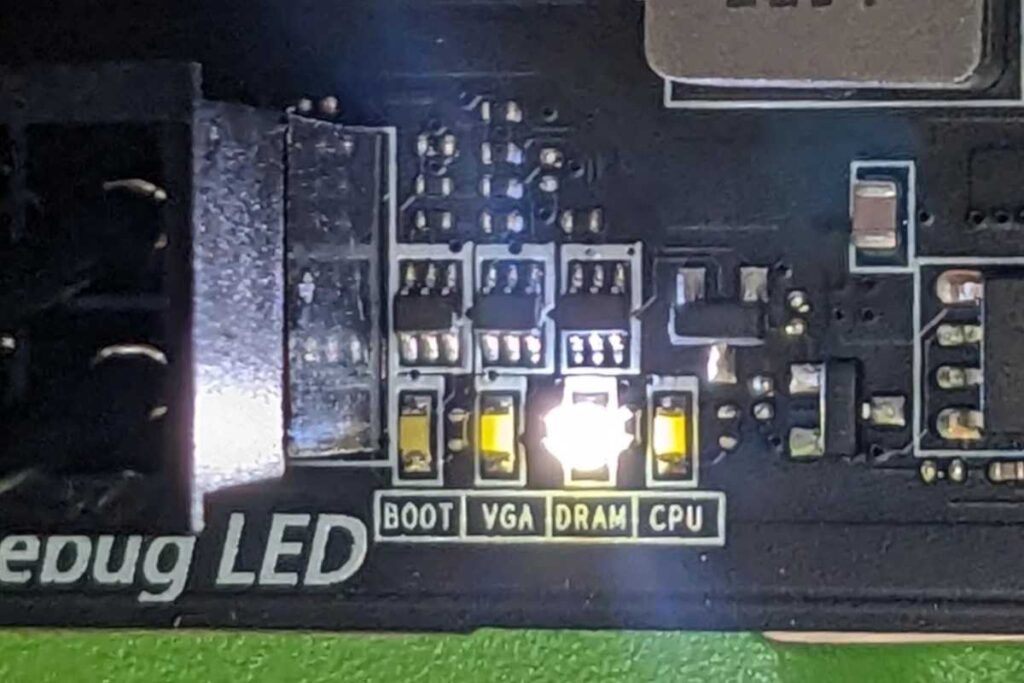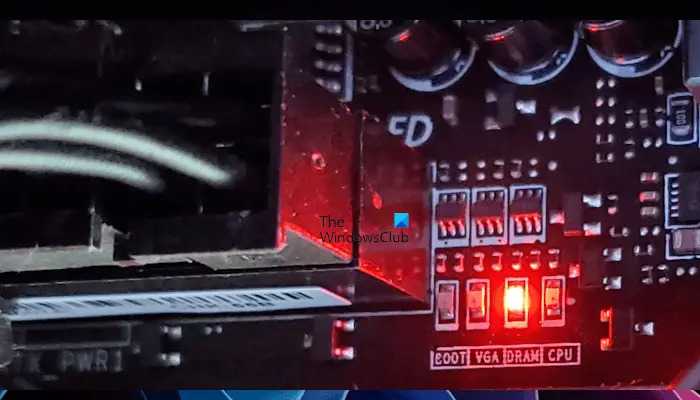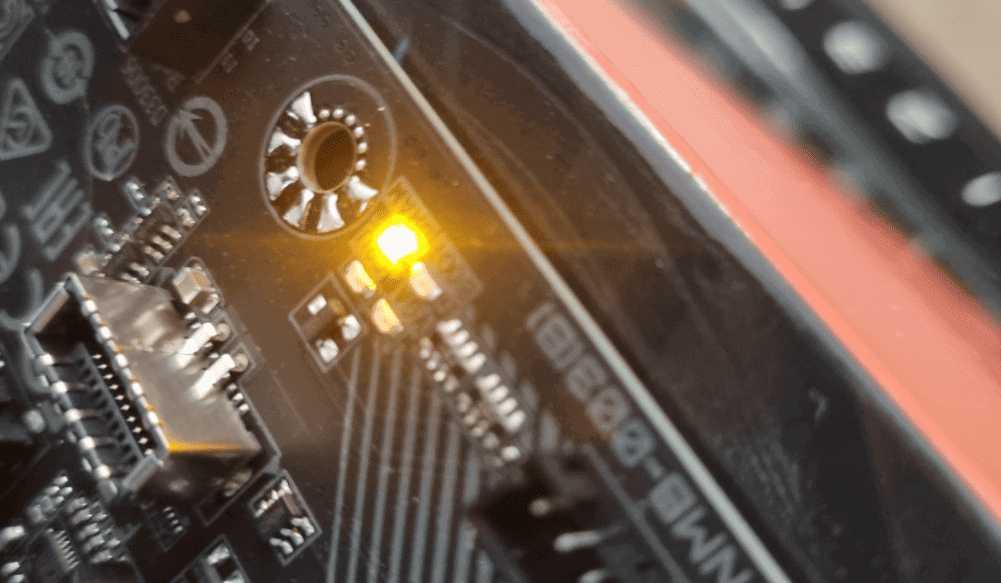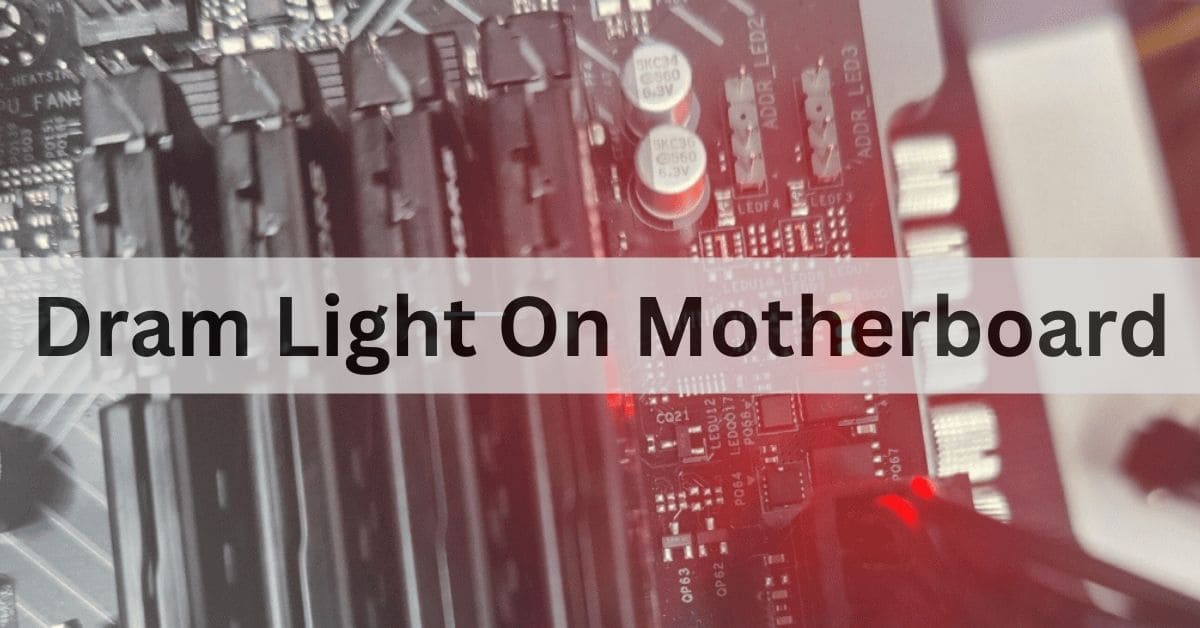When the DRAM light on my motherboard lit up, I worried my system was failing. After resetting the RAM, the light turned off, and my computer worked perfectly again. This taught me to always check connections first!
The DRAM light on a motherboard usually means there is a problem with the RAM. It can be caused by loose connections or faulty memory. Checking and reseating the RAM can often fix this issue.
In this article, we will discuss all about “Dram Light On Motherboard”.
Table of Contents
Why is my DRAM light on my motherboard?

The DRAM light on your motherboard may be on due to loose or faulty RAM. It can also signal a compatibility issue. Try reseating the RAM or checking if it matches the motherboard’s requirements to fix the problem.
Read More: Is The 3060 Compatible With My Motherboard – Compatibility Guide You Need!
What does DRAM mean on a motherboard?
DRAM stands for Dynamic Random Access Memory. It is a type of memory used in computers and motherboards to store data temporarily. DRAM helps the system run programs and applications quickly by providing fast access to information when needed.
How do I fix my DRAM debug light?
To fix your DRAM debug light, start by reseating the RAM sticks. Make sure they are properly connected. If the light stays on, try using different RAM slots or testing with another RAM stick to identify the issue.
Why is the DRAM light on my motherboard lit?
The DRAM light on your motherboard is lit because it detects a problem with the RAM. This could be due to loose connections, incompatible RAM, or faulty modules. Checking and reseating the RAM sticks often helps fix this issue.
What does the DRAM light on the motherboard indicate?
The DRAM light on the motherboard usually shows a problem with the RAM. It can mean the RAM is not installed correctly, is damaged, or is not compatible with the motherboard. Checking connections or replacing the RAM can help fix it.
How can I troubleshoot the DRAM light issue on my motherboard?
Check RAM Seating:
Checking RAM seating is important for your computer to work properly. Make sure the RAM sticks are firmly in their slots. If they are loose, it can cause problems like errors or the computer not starting.
Test RAM Modules:
To test RAM modules, turn off your computer and remove them. Then, clean the contacts and reinstall them one by one. Start your computer to check if it works correctly. This helps find any faulty RAM easily.
Inspect Motherboard Connections:
To inspect motherboard connections, check all cables and parts. Make sure everything is securely plugged in and there are no loose connections. This simple step can help fix issues and keep your computer running smoothly.
What should I do if the DRAM light stays on?
If the DRAM light stays on, check if the RAM is properly seated in the slots. Remove and reinsert it if needed. Also, ensure the RAM is compatible with your motherboard. If the light remains on, test with different RAM sticks.
Can a faulty RAM cause the DRAM light to turn on?
Defective Memory Modules:
Defective memory modules can cause problems in your computer. They may lead to crashes, freezes, or errors during use. It’s important to check and replace faulty modules to keep your system running smoothly and efficiently.
Incompatible RAM:
Incompatible RAM happens when the memory sticks do not work with the motherboard. This can cause problems like system errors or failure to start. Always check the motherboard’s manual for compatible RAM types before purchasing to avoid issues.
Improper Installation:
Improper installation of a motherboard can cause various problems. This includes issues like not starting up, random shutdowns, or errors. Always ensure all screws and connections are tight to avoid these issues and keep your computer running smoothly.
Does the color of the DRAM light matter?

Yes, the color of the DRAM light can matter. A green light usually means everything is okay, while a red or yellow light may indicate a problem with the RAM. It’s important to check and fix any issues right away.
Read More: Are All Graphics Cards Compatible With All Motherboards – Compatibility Explained!
Why is the DRAM light always on on my Asus motherboard?
If the DRAM light is always on your motherboard, it usually means the RAM has a problem. Check if the RAM sticks are properly installed or try reseating them. If the issue persists, consider testing with different RAM.
Motherboard DRAM LED keeps lighting up:
If the motherboard DRAM LED keeps lighting up, it usually means the RAM has a problem. Try reseating the RAM sticks or replacing them if needed. This can help fix issues and get your system running again.
What to Do If DRAM Light on Motherboard Is Turned On?
If the DRAM light on your motherboard is on, check the RAM sticks. Make sure they are properly seated in their slots. If the light stays on, try using different RAM or testing each stick individually to find any issues.
DRAM light on motherboard orange?
An orange DRAM light on your motherboard means there is a problem with the memory. Check if the RAM sticks are properly seated or try using different slots. If the light stays on, the memory might need replacing.
How can I check if my RAM is properly seated?
To check if your RAM is properly seated, turn off your computer and unplug it. Open the case and gently press down on the RAM sticks to make sure they fit snugly. If they click into place, they’re properly seated.
Can I still use my computer with the DRAM light on?
If the DRAM light is on, your computer may not work properly. You can try restarting or reseating the RAM sticks. If it stays on, there may be a problem that needs fixing before using the computer again.
How to fix dram light on motherboard?
If the DRAM light is on, your computer may not work properly. You can try restarting or reseating the RAM sticks. If it stays on, there may be a problem that needs fixing before using the computer again.
DRAM light on motherboard white?
When the DRAM light on the motherboard is on, it usually means there’s an issue with the RAM. Check if the RAM is installed correctly or try reseating it. This can often fix the problem quickly.
When should I replace my RAM if the DRAM light is on?

If the DRAM light is on, check the RAM connections first. If they are secure and the light stays on, it may be time to replace the RAM. Faulty RAM can cause system errors and crashes.
Read More: Why Are Ddr5 Motherboards So Expensive – Discover The Hidden Costs!
FAQs:
1. What does the DRAM light on the motherboard indicate?
The DRAM light signals an issue with the RAM or its connection. It usually means the motherboard is not detecting the RAM properly.
2. How can I troubleshoot the DRAM light issue?
Start by checking if the RAM is seated correctly in its slots. If the light remains on, try testing each RAM module individually in different slots.
3. What should I do if the DRAM light stays on?
If the DRAM light stays on, reseat the RAM modules and check for any visible damage. If the problem persists, consider replacing the RAM.
4. Can faulty RAM cause the DRAM light to turn on?
Yes, defective memory modules, incompatible RAM, or improper installation can cause the DRAM light to activate. It indicates a problem that needs to be addressed.
5. Does the color of the DRAM light matter?
Yes, the color can indicate different issues. Typically, a red or yellow light suggests a serious problem, while a blinking light may indicate a temporary issue.
Conclusion:
The DRAM light on your motherboard is a crucial indicator of potential RAM issues. It can arise from faulty memory, improper installation, or compatibility problems. Troubleshooting this light is essential for ensuring your computer operates smoothly. If the light persists after reseating or replacing the RAM, it may be necessary to consult a professional. Being proactive about these indicators can save you time and prevent further damage to your system.
